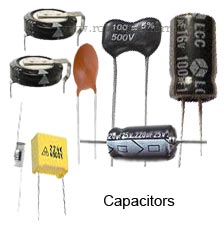Capacitor Tutorial
Capacitor is one of those fascinating devices which are horrible when they go wrong and absolute brilliance when they do their work. Let us go in detail and understand what are capacitors and their applications.
Introduction to Capacitors
Capacitors (A.K.A condensers) are components which store electric charge or energy when voltage is applied across them. Unlike a battery where new electrons are formed by a chemical reaction, capacitors act only as electron storage banks and do not produce them. A battery may take days, or even years (like a Quartz watch) to release its energy, whereas a capacitor may take seconds, or even less to release all of its energy. We will see what a capacitor is made of, and then understand how it magically makes electronics more interesting.
A simplest form of capacitor contains two parallel conducting plates separated by an insulating material, which is usually ceramic, mica, tantalum, air, paper, or even vacuum. This insulating material is known as dielectric.
If you are not already aware, look up to the sky and you see a huge capacitors floating. Yes, the clouds. Clouds are nothing but accumulation of moisture which combine together to form ice particles and water droplets.  These particles collide against each other which cause electrons to be released. The negatively charged particles accumulate at the bottom gaining electrons, and the positive charged particles that have lost electrons accumulate at the top of the cloud. Now there is a gigantic capacitor floating around with positively charged plate at the top and negatively charged plate at the bottom. If you are still interested to know what happens next, the negative charge at the bottom of the cloud repels the negative charge on the ground to make it positively charged. If the charge is really high, air breaks down to form ionized-air and creates a path for electrons to flow from clouds to ground. This sudden surge of electrons from cloud to ground shorts them causing a huge spark which is very well known as Lightning.
These particles collide against each other which cause electrons to be released. The negatively charged particles accumulate at the bottom gaining electrons, and the positive charged particles that have lost electrons accumulate at the top of the cloud. Now there is a gigantic capacitor floating around with positively charged plate at the top and negatively charged plate at the bottom. If you are still interested to know what happens next, the negative charge at the bottom of the cloud repels the negative charge on the ground to make it positively charged. If the charge is really high, air breaks down to form ionized-air and creates a path for electrons to flow from clouds to ground. This sudden surge of electrons from cloud to ground shorts them causing a huge spark which is very well known as Lightning.
Capacitor technicality
For technically inclined folks, one of the conducting plate holds a positive charge (+Q), and the other holds a negative charge (-Q). The overall charge in a capacitor is referred as Q which is based on the surface area of conductive plates and insulating medium between them.
The amount of electrical energy a capacitor can store (or simple Capacitance) is measured by measuring the charge on the plates and the voltage applied. Capacitance is dependent on the area of the plates, distance between them and the dielectric used between them.
'V' is applied to a capacitor and overall charge in the capacitor is ‘Q’, then ratio of charge to voltage gives Capacitance 'C'.
C = Q/V
To calculate charge on a capacitor, the above equation can be rearranged as:
Q = CV
Farad (F). When a voltage of one Volt (V) is applied on a capacitor and one Coulomb (C) of charge is stored on the capacitor plates, then capacitance can be calculated as:
C = Q/V => 1/1 => 1F
µF(1 micro Farad = 10-6F), nF (1 nano Farad = 10-9F) and pF (1 Pico Farad = 10-12F); millifarad is by itself very large for our applications.
To charge a capacitor, there should be some amount of work done which is equal to the energy stored in a capacitor. Energy is measured in Joules and energy in a capacitor can be measured as W = 1/2 CV2 or W = V2 * C/2, where W is energy in Joules, V is voltage in Volts and C is capacitance in Farads. Although these are complex derivations, we do not need to understand them for our basic capacitor introduction.
Tutorial index:
Do you have anything to say?
Visit the Forum to discuss, learn and share anything related to robotics and electronics !!








